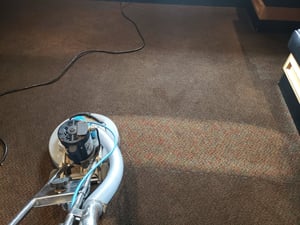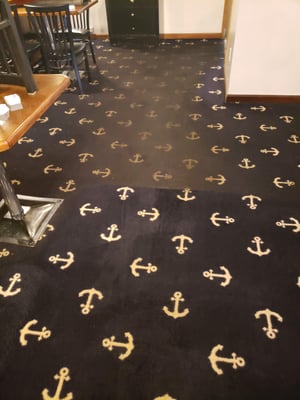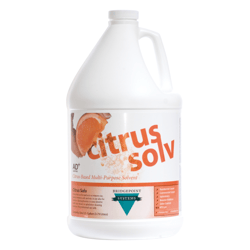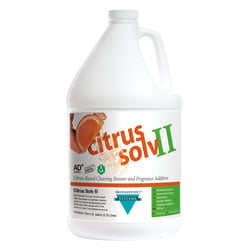The presence of excessive oils in carpets is due to the environment and the type of carpet. The preparation of meals using a food source like meat with an abundance of fat can be the culprit. Also, some foods are cooked in hot oils like chicken and fries. Some of these oils splatter or become airborne and land on the floor in the kitchen. These greasy deposits are carried by shoes onto carpets in adjacent rooms.
In some restaurants, a path of bonded oil is visible from the kitchen door into the dining room. Greasy carpet has always been an issue but has been exacerbated by the dramatic increase in the sales of polyester carpets. Oil loves to bond to polyester which also includes olefin and triexta fiber.
Cleaning Chemicals for OilProfessional cleaners have demanded commercial carpet cleaning equipment that deals with the significant oil build-up. The result was a combination of non-ionic surfactants, high alkalinity, and solvent blends. Powdered formulas provide a practical way to include d’limonene directly in the product. However, the additional step of adding a citrus booster to other ready-to-use alkaline pre-spray is a definite benefit when degreasing. Some of these boosters are easier to rinse out of carpet than others, which is more important for polyester carpets. These types of formulas were designed for use on difficult oily & particulate soil prevalent in polyester-type carpets and for other carpets in need of degreasing. These high alkaline-based solvent and surfactant cleaners will remove years of built-up grease and soil, especially when combined with agitation and hot water extraction.
Step One
The first step after vacuuming soils not bonded to the grease or carpet is to liberally spray an aggressive pre-spray outlined above. It is important to give the pre-spray several minutes of dwell time to penetrate into the oils, starting the emulsification process.
Step Two
The second step is to use some form of agitation to help the prespray penetrate the oils bonded on the surface. The ideal tool is to use a counter-rotating brush machine. A counter-rotating brush can save time as it lessens the amount of necessary dwell time.
Step Three
The third step is to extract with hot water and rinses fortified by both alkalinity, surfactancy, and rinse agents. Some areas will benefit from additional wand strokes to get rid of any remaining visible soils.
Step Four
The fourth step is proper drying. This includes additional dry strokes to extract as much soil from the depth of the carpet. You will also need to set up fans to accelerate the drying.
Polyester is notorious for being dry on the top of the carpet and remaining wet at the level of the primary backing. This occurs because polyester does not absorb liquid into the fiber-like nylon. This results in a higher level of moisture in the depths of the carpet. In some instances, it is appropriate to use a cotton bonnet to absorb additional moisture in the most soiled areas.
Step Five
The final step is adding a specialty product that neutralizes alkalinity, limits wicking, and provides some soil resistance until the next cleaning. It is important to remember that the application of the chemical does not stand by itself, it works in conjunction with a thorough rinsing and sufficient drying.
These steps will provide a good result. In some cases, better results will come from more frequent extractions cleanings of both tile and carpet, better maintenance solutions to control oil build-up on hard floors in the kitchens, and walk-off mats at the point of confluence between the tile and carpet.
Featured Products

 Bridgepoint Systems, Cleaning Booster Citrus Solv II, 1 Gallon
Bridgepoint Systems, Cleaning Booster Citrus Solv II, 1 Gallon
 Hydro-Force, Injection Sprayer Pro, 5 Quart
Hydro-Force, Injection Sprayer Pro, 5 Quart
